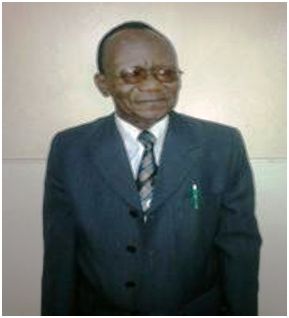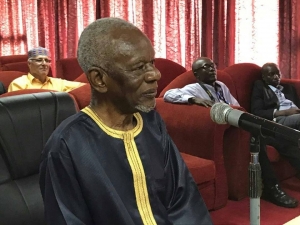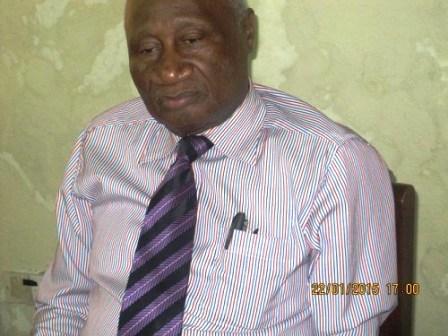State of the Arts: IMC Recognising excellence in media in Sierra Leone
The Independent Media Commission (IMC) recently extended the deadline for submission of entries for its annual awards. (Photo: IMC Chairman: Rodmac Johnson)
Journalists, regular contributors and newspaper columnists had up to 15 February, instead of the initial January 31 deadline, to submit their entries.
The Commission also broadened the period covered for eligible entries – January 1 to December 31, 2012 – allowing potential contributors to chose from their best work within the 12 month period to fill at least one of a total of 24 categories.
As has been the norm, there will be recognition for excellent reporting in these selected key areas, covering science, politics, arts, economics and education.
There will also be recognition for the best work in photojournalism, cartoon, as well as radio drama and magazine programs.
But while in the past media institutions were required to submit their entries for best newspaper layout design, this time round the winner for this category will be chosen through an internal review process. In other words, judges will make selection out of the IMC`s archive.
The same method will obtain for the category of best photojournalism.
According to Battiloi Warritay, Director of Monitoring and Research Unit at the IMC, this will ensure that the best work is chosen from serious outlets with relative constancy in producing quality work. He argued that having media practitioners bringing in their best entries for these categories may encourage the wrong judgement as such entries might not necessarily reflect their pattern right across.
Among the 94 newspapers now said to be registered with the IMC not more than 30 are operational at every given point in time. And in categories where the Commission will have to make internal selections only about 25, based on their consistency of publication, qualify for consideration.
Awards night
Another new introduction to the annual national awards is the creation of categories of sponsorships.
Depending on what they provide, sponsors will be tagged as Diamond, Silver, Rutile, Iron ore or Bronx. The idea is to get them compete for an opportunity to show commitment to the improvement of the Sierra Leone media, said Warritay.
“In this regard we are attempting to challenge the private sector and other development institutions to be excited about the awards… We are looking for partners to help give credit to media practitioners that have excelled in 2012,” he added.
Preparation for the 2013 edition of the awards started a little late mainly due to the busy November electioneering process which coincided with the festive season of December. This somehow affected the Commission by way of dissemination of information.
In fact, hardly was the journalist community itself aware well enough when announcement for submission of entries was first made in January.
Nonetheless, so far indications are that the Commission is on track to meet its target ahead of the awards night, slated for April 19th.
Judges will be looking for a wide range of points, with emphasis on relevance, accuracy and the extent to which journalists research their work.
The use of statistics, attribution, clarity and originality will also contribute in determining the eventual winners across the various categories.
The Commission is maintaining its practice of giving out indigenous Sierra Leonean carvings as awards, undoubtedly a commendable patriotic move.
But one other area where the IMC seems to have overlooked in the organisation of this noble ceremony is the possibility of creating more winners than losers of the night?
As far as we know, this is a national award and the most prestigious one at that for local journalists.
Like in all competitions, not everyone will win, but it sure will make a big difference if recognition is done of the effort made by those who may miss out just narrowly. Say the top three submissions of each category are called, their citations read, and then the ultimate winner is announced. This will not only accord the judges the opportunity to explain [justify] why a particular winning article was chosen, but also each of these works can be recognised.
Crucially, this will also encourage the runners-up to try a little harder the next time.
Gender representation
Existing levels of disproportionate gender representation in the media in Sierra Leone are a constant reminder of the woes the women folks go through in a persistently patriarchal society.
Imagine in a media environment with 94 newspapers and over 60 radio stations, among others, only one notable female ‘editor’ is recognisable from the lots.
The ‘Best Female Reporter’ award therefore illustrates the Commission`s intent in singling out the few struggling women writers and broadcasters for their courage.
After all, most of the prizes presently go to the men, thanks to the high male proportion in the profession.
Such an award is therefore also well placed to send a signal for the encouragement of institutions to give women more space in the media.
“…we will want to see more women; they should be given ways to do so… It also is to provide an incentive for their extreme effort,” said Warritay.
However, not everyone will be happy on the night of April 19.
Proponents of the Tourism industry may particularly want to know why the ‘best report on tourism’ category was removed.
There is also the issue of awards for commercial radio stations. Do they contribute any relevance to society beyond their money making venture?
There is a substantially large number of radio stations in this country, from privately-owned commercial, religious, to community radio stations. While some of these have a blend of commercial and news broadcasting services, others are strictly religious. A highly negligible few, notably Capital Radio, are strictly commercial.
However, a major similarity with them all is the occasional entertainment segment.
In essence, each one of them brings a certain value, argued Warritay.
“They all lend values in their own ways… They are commercial, business oriented, but they have a role to play,” he said.
The award for commercial radios, Warritay added, can serve as an evaluation on their performance. The performance of DJs can determine that of the station. Those DJs who prefer to exhibit western norms are liable to making their stations irrelevant to the local audience. This could arguably run against their stand.
By: Kemo Cham, SaloneJamboree
Stay with Sierra Express Media, for your trusted place in news!
© 2013, https:. All rights reserved.






